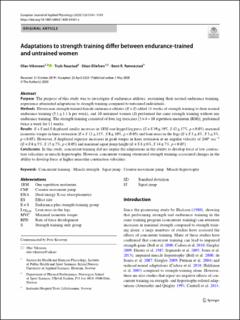Adaptations to strength training differ between endurance-trained and untrained women
Peer reviewed, Journal article
Published version
Permanent lenke
https://hdl.handle.net/11250/2727161Utgivelsesdato
2020Metadata
Vis full innførselSamlinger
- Artikler / Articles [2119]
- Publikasjoner fra Cristin [1107]
Originalversjon
European Journal of Applied Physiology. 2020, 120(7), 1541-1549. 10.1007/s00421-020-04381-xSammendrag
Purpose: The purpose of this study was to investigate if endurance athletes, sustaining their normal endurance training, experience attenuated adaptations to strength training compared to untrained individuals. Methods: Eleven non-strength-trained female endurance athletes (E + S) added 11 weeks of strength training to their normal endurance training (5.1 ± 1.1 h per week), and 10 untrained women (S) performed the same strength training without any endurance training. The strength training consisted of four leg exercises [3 × 4 − 10 repetition maximum (RM)], performed twice a week for 11 weeks. Results: E + S and S displayed similar increases in 1RM one-legged leg press (E + S 39 ± 19%, S 42 ± 17%, p < 0.05), maximal isometric torque in knee extension (E + S 12 ± 11%, S 8 ± 10%, p < 0.05) and lean mass in the legs (E + S 3 ± 4%, S 3 ± 3%, p < 0.05). However, S displayed superior increases in peak torque in knee extension at an angular velocity of 240° sec−1 (E + S 8 ± 5%, S 15 ± 7%, p < 0.05) and maximal squat jump height (E + S 8 ± 6%, S 14 ± 7%, p < 0.05). Conclusions: In this study, concurrent training did not impair the adaptations in the ability to develop force at low contraction velocities or muscle hypertrophy. However, concurrent training attenuated strength training-associated changes in the ability to develop force at higher muscular contraction velocities.
Beskrivelse
This article is licensed under a Creative Commons Attribution 4.0 International License, which permits use, sharing, adaptation, distribution and reproduction in any medium or format, as long as you give appropriate credit to the original author(s) and the source, provide a link to the Creative Commons licence, and indicate if changes were made. The images or other third party material in this article are included in the article's Creative Commons licence, unless indicated otherwise in a credit line to the material. If material is not included in the article's Creative Commons licence and your intended use is not permitted by statutory regulation or exceeds the permitted use, you will need to obtain permission directly from the copyright holder. To view a copy of this licence, visit http://creativecommons.org/licenses/by/4.0/.
